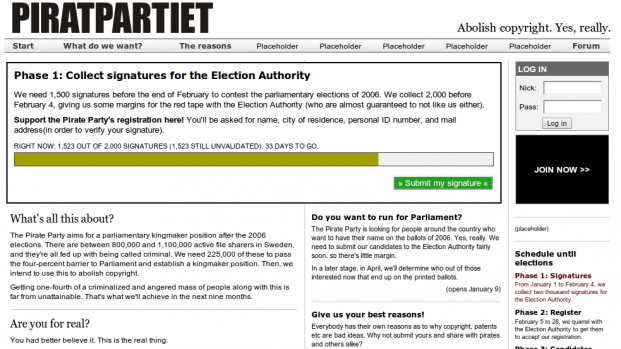Swarmwise – The Tactical Manual To Changing The World. Chapter Two.
Falkvinge on Infopolicy 2013-03-15
Summary:

Swarm Management: Launching a swarm is an intense event, where you can get hundreds or thousands of new colleagues in less than a day. You have a very short window for appreciating their interest, or they will take it elsewhere.
The actual book is expected to be available by June 1, 2013.
Ok, so you have a provocative idea. You’ve done the math. Everything appears good to go. How do you gather a swarm around the idea?
A traditional method would be to go about an advertising campaign to generate interest. Working swarmwise, though, two words about the idea of an advertising campaign: forget it. If your idea doesn’t generate enthusiasm on its own, no amount of whitewashing is going to create the grassroots activism that you need to form a swarm.
On the other hand, a swarm will form as long as you present a compelling enough idea that people feel that they can be part of. You don’t need to spend ten million on an advertising campaign. It can be enough to mention the idea just once in passing in a semi-obscure chat channel.
To traditional economists, this sounds ridiculous. But that’s what I did to kickstart a brand that’s now well known in the IT sector worldwide and has local presence in fifty-plus countries.
When I started the Pirate Party in Sweden, I took its website online, and wrote two lines in a file sharing hub’s lobby chat. This was on January 1, 2006, at 20:30 CET.
Hey look, the Pirate Party has its website up after New Year’s. http://www.piratpartiet.se/
The site had a manifesto which was rough, unpolished, but which came across as credible, tangible, inclusive, and world-changing. The site itself was just as rough and unpolished – which is the typical swarm way of trial and error, of putting a stake in the ground and evolving from there:

The first website of the Pirate Party, translated for reference. It is no overstatement that it was rough and unpolished.
And that’s it. Those two lines announcing the rough-looking site are all the advertising I ever did. The next two days, the site got three million hits. (Sweden has nine million people.) Media caught on quickly too. Worldwide. On the third day, my photo was in a Pakistani paper.
My point here is, if you’re thinking hard about how to gather a swarm for your idea:
Don’t worry about advertising.
Word of mouth is much more efficient than any campaign can ever be, but that requires that your idea – or rather, your presentation of it – meets four criteria: Tangible, Credible, Inclusive, and Epic.
- Tangible: You need to post an outline of the goals you intend to meet, when, and how.
- Credible: After having presented your daring goal, you need to present it as totally doable. Bonus points if nobody has done it before.
- Inclusive: There must be room for participation by every spectator who finds it interesting, and they need to realize this on hearing about the project.
- Epic: Finally, you must set out to change the entire world for the better – or at least make a major improvement for a lot of people.
If these four steps are good, then the swarm will form by itself. Quite rapidly, in the twenty-odd cases I have observed firsthand. Very rapidly. On the other hand, if these four components are not good enough, no amount of advertising or whitewashing is going to create the volunteer activist power that you want.
Let’s take a look at sample project plans. I’ve seen many examples of all of these three types.
A BAD EXAMPLE OF A PROJECT PLAN
Oh boy I am so starting a new project t0talli for Das Lulz!!11!!!oneone!!six!!11 lololol I wonder what I will put in it?
ANOTHER EQUALLY BAD EXAMPLE
We are seeking a synergy between results-oriented actitivies related to dyna